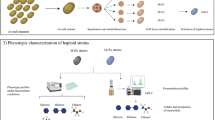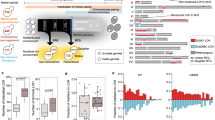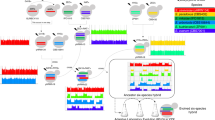Abstract
AT irregular intervals, yeast geneticists have reported1 the origin of asporogenous yeast types by the direct germination of spores. Naturally, they were entitled to believe that asporogenous yeasts generally referred to as Torulæ may have had a similar origin. Their suggestion that all asporogenous strains are ‘haploid’ could, however, be considered valid only if polyploidy did not occur in yeasts.
This is a preview of subscription content, access via your institution
Access options
Subscribe to this journal
Receive 51 print issues and online access
$199.00 per year
only $3.90 per issue
Buy this article
- Purchase on Springer Link
- Instant access to full article PDF
Prices may be subject to local taxes which are calculated during checkout
Similar content being viewed by others
References
Winge, Ö., and Laustsen, O., C.R. Lab. Carlsberg, Ser. Physiol., 22, 99 (1937). Lindegren, C. C., and Lindegren, G., Ann. Mo. Bot. Garden, 31, 203 (1944).
Subramaniam, M. K., Curr. Sci., 14, 234 (1945); Proc. Nat. Inst. Sci. India, 13, 129 (1947); Cellule, 54, 145 (1951a). Subramaniam, M. K., and Ranganathan, B., Proc. Nat. Inst. Sci. India, 14, 279 (1948). Ranganathan, B., J. Ind. Inst. Sci., 32 A, 91 (1950).
Duraiswami, S., and Subramaniam, M. K., Cellule, 53, 215 (1950). Subramaniam, M. K., J. Ind. Inst. Sci., 32 A, 29 (1950).
Ranganathan, B., and Subramaniam, M. K., Proc. Nat. Inst. Sci. India, 14, 389 (1948). Royan, S., and Subramaniam, M. K., Nature, 169, 932 (1952).
Subramaniam, M. K., Curr. Sci., 20, 257 (1951b).
Windisch, S., Arch. Mikrobiol., 9, 551 (1938).
Lodder, J., and Kreger-Van Rij, N. J. W., “The Yeasts: a Taxonomic Study” (1952).
Subramaniam, M. K., Proc. Nat. Inst. Sci. India, 14, 315 (1948).
Subramaniam, M. K., and Raganathan, B., Nature, 157, 657 (1946).
Thomas, P. T., Nature, 156, 738 (1945).
Subramaniam, M. K., Proc. Nat. Inst. Sci. India, 12, 143 (1946). Duraiswami, S., and Subramaniam, M. K., Experientia, 7, 422 (1951).
Lindegren, C. C., and Lindegren, G., J. Gen. Microbiol., 5, 885 (1951).
Author information
Authors and Affiliations
Rights and permissions
About this article
Cite this article
SUBRAMANIAM, M., RANGANATHAN, B. Are Torulæ Haploid?. Nature 172, 628–629 (1953). https://doi.org/10.1038/172628a0
Issue Date:
DOI: https://doi.org/10.1038/172628a0
This article is cited by
-
The cytology of yeasts
The Botanical Review (1964)
-
Das Absterben von Hefen unter der Einwirkung von Noxen in Abhängigkeit vom Ploidie-Grad
The Science of Nature (1955)
Comments
By submitting a comment you agree to abide by our Terms and Community Guidelines. If you find something abusive or that does not comply with our terms or guidelines please flag it as inappropriate.



